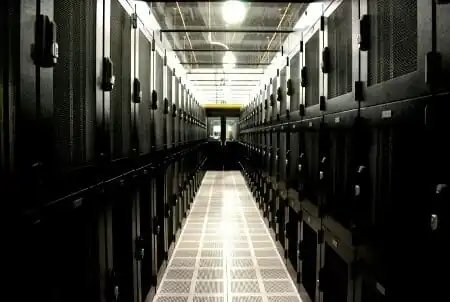Air Segregation: How to Measure Effectiveness11 min read

The following post was contributed by Adrian Honeybill, the Group Lead for Energy and Sustainability for TeleCity Group.
The following is an overview on a subject that has many scientific and engineering papers written and available in the public domain. Avoiding the ‘blinding with science’ approach I present a pragmatic view of air segregation effectiveness.
Why Bother With Measurements?
Did I hear a rumble of ‘Yes why bother measuring air temperature? The cold aisle is segregated from the hot aisle!’…. Oh really…how do you know?
Yes, I am playing the ‘devil’s disciple’, that classic counter position to prove a point. In this case the point is that only by measurement can you see how effectively the cold and hot aisles are operating.
I am proposing that we look at one metric, air temperature, however viewed from an alternative perspective.
Supply and Demand
Why do we supply air into the cold aisle? What is controlling the supply of air into the cold aisle?
Traditionally cold air has been delivered into the cold aisle with fixed constant rate fan systems. Within the last 5 years, manufacturers of cooling systems have come to understand the need for variable flow fan systems, driven by the energy savings available from variable or electronic control (EC) fan systems. The control fan speed has been controlled by temperature set point and the control provided by digital proportional, integral, derivative based control algorithms. In cold aisle containment configurations we have learned to use supply air temperature control (as compared to return air temperature control) to maintain stable cold aisle temperature. That is the theory; now what happens in the IT rack.
The IT equipment usually has its own fan based cooling system (water based IT equipment cooling is not part of this discussion) and the current designs are predominantly using variable speed fans to match IT equipment cooling demand. The demand for cold air is totally controlled by these fan systems. As compute loads vary, so does the IT equipment demand for cooling air as heat builds within the IT equipment as computational demand increases/decreases; the fan systems step up, or down, to meet the cooling demand. The air containment/segregation in the cold aisle is now paramount to how the IT equipment works and in consequence, how the cooling system operates as the relationship between the two is indivisible.
The Enemies of Air Segregation
In cold aisle architectures we are aiming to eliminate the two enemies of segregated air:
- Recirculating air – Recirculated air occurs when hot air from the IT equipment is allowed to flow into the IT equipment intake, either by recirculation within the rack, or by recirculation outside the rack.
- Bypass air – Bypass air occurs when unblanked areas in the face of the rack, or the raised floor, allows air to travel through the data centre without providing any cooling benefit to the racked IT equipment.
The Consequences of Uncontrolled ‘Enemies of Air Segregation’
With recirculating air we see the first ‘enemy of air segregation’ with IT equipment inlet temperatures above the cold aisle set point, reducing, or in extreme circumstances eliminating any benefit of supplying cold air that the cold aisle provides – a constant controlled temperature environment. In some cases the temperature deviation provides service level agreement breach conditions. Generally we also see temperature variations on the vertical rack face with lower temperatures at floor level and higher temperatures at the top of the rack. Depending on how the recirculation is occurring within the rack, we also see hot spots on the face of the rack, at differing levels. To see what is happening, try using a thermal imaging camera. Be prepared for some amazing and shocking images. Recirculating air around the sides of adjacent, nominally touching racks, together with hot air coming from under the bottom front of the rack, look on the screen like a creeping multi-colored mist of horror!
Now let us add bypass air. Air passing from the cold aisle into the hot aisle, without passing through IT equipment, only dilutes the hot air temperature. The bypass can come from no blanking panels. It can also come from floor grilles positioned in the hot aisle, together with open apertures in raised floor cable entry points. The end result is the air returning to the air handling or condition unit (CRAH or CRAC) is not allowing the temperature difference between the cold and hot air to be maximized, providing the optimum conditions for peak cooling equipment efficiency.
In both cases, only by critical and detailed assessment of air segregation and understanding how we use the tools in our armoury of air segregation will we be able to defend ourselves from air contamination.
To Measure is to Manage
So how do we build a performance metric that allows us to gauge the effectiveness of the segregation of the cold and hot air?
- Cold aisle effectiveness – Measure the supply air temperature and the cold aisle temperature*. If your air segregation is 100% there will be no difference in the two readings. The wider the difference, the greater the lack of segregation and the greater the recirculating/bypass air.
- Hot aisle effectiveness – Then look at the return air temperature and compare to the supply air temperature. The manufacturer’s documentation should indicate the optimum temperature difference for energy efficiency. You should be looking for a temperature difference of 10º to 12º Celsius (18º to 21.6º Fahrenheit). (If the documentation does not provide any guidance – ask the manufacturer!)
*Measure the cold aisle temperature in mid aisle, at three levels – floor, half way up and at the top of the rack. The difference should be negligible (less than 1degC) in a correctly segregated cold aisle.
So What’s Next?
You now believe that you have reached cold aisle Utopia…Cloud 9! Not quite.
The next step is to look at the air speed coming through the floor grilles and the control of the fan system. With excessive air supply due to the use of temperature based fan control systems, fan energy efficiency is very low. With the cold aisle now totally segregated from the hot aisle, differential air pressure control can be used. Using variable speed (EC) fans set to provide an air pressure set point of 2-5 Pascal, you are optimizing your cooling fan energy use. Your fan energy savings could be well over 50% and you have yet to look at chilled water temperatures and to check that cold aisle set points are in line with ASHRAE class 1 (up to 27º Celsius, 80.6º Fahrenheit). Your journey has just started, and we have yet to see what is around the corner from the IT equipment/chip manufacturers. Who said that we’ve gotten all the blood out of the stone?

Adrian Honeybill
Program Manager, EMEA PMO - Engineering
Let's keep in touch!.
4 Comments
Submit a Comment
Airflow Management Awareness Month
Free Informative webinars every Tuesday in June.
The initial issue over the ‘50-53F issue’ requires clarification. The article refers to a differential temperature, otherwise known as ΔT, of 10 to 12 degsC, or in imperial measurement, 18 to 21.6 degsF. Therefore, with an inlet temperature of 24 degsC the outlet temperature would be 24 degsC (75.2 degsF) plus 10 degsC (18 degsF) = 34 degsC (93.2 degsF). I trust this clears up the point and apologies if any ambiguity crept in.
The second issue concerning the use of a 2 Pascal set point on the cold aisle pressure based control is from a technology demonstrator we set up in one of our purpose made cold aisle segregated systems. We have a full set of test results from our study, including energy efficiency improvements and return on investment calculations.
The cold aisle is 1.8m wide, rack face to rack face and 4m high from raised floor to ceiling. The aisle is 20, 800mm wide racks long. With that we have a volume in the cold aisle of 1.8x16x4 cubic metres of air. This volume provides sufficient volume to buffer the changes of variable IT equipment fan speed to the sensitivity pressure set point control system. I agree that in more conventional cold aisles, the issue would be more exacerbated without the level of cabinet sealing, however the system is a bespoke build to our specification and where we do have control over rack blanking etc. Also in a conventional rack system there cold aisle air volume is about half, increasing the vulnerability of the system to rack fan operational variations, and the effect on the EC fan control system.
Regarding this comment, “You should be looking for a temperature difference of 10º to 12º Celsius (50º to 53.6º Fahrenheit).”, since we are looking at delta T, the degrees F should be 18-21.6F. It looks like someone converted 10C and 12C to F directly, but since it is Delta T, the conversion is 1.8 degrees F per degree C, no need to add 32 since we aren’t talking about absolute temperatures.
Adrian
Is the real optimum temperature for a cooling unit 50-53F? That seems a little high when most servers are designed for 20-30F temperature differential from inlet to exhaust. In a perfectly seemed thermal system that would mean our servers would have a 50F delta T. I would love to operate a datacenter with those kinds of Delta’s, but few every really go over 10-15F. One of my tenants runs high density power cabinets at 35-38 KW and we only see about 35-40F delta on those cabinets.
Additionally, a better pressure setpoint to use for control would be a variable pressure delta. A fixed PASCAL setpoint does not respond to the server fan speeds continuously changing and affecting the cold aisle static pressure felt by each server. A variable setpoint would also compensate (to a small degree) small bypass issues that occur from equipment additions and removals with less than perfect cabinet sealing. My thoughts are that until our industry truly adopts the philosophy that heat containment practices have to be practiced 100% and every cabinet, POD, or containment must be air tight we will continue to chase efficiency improvements.
Right on the money, Jay. Pressure based control is the only way to relate volume of air throughput.